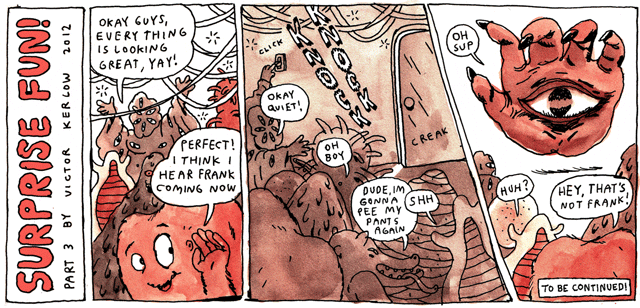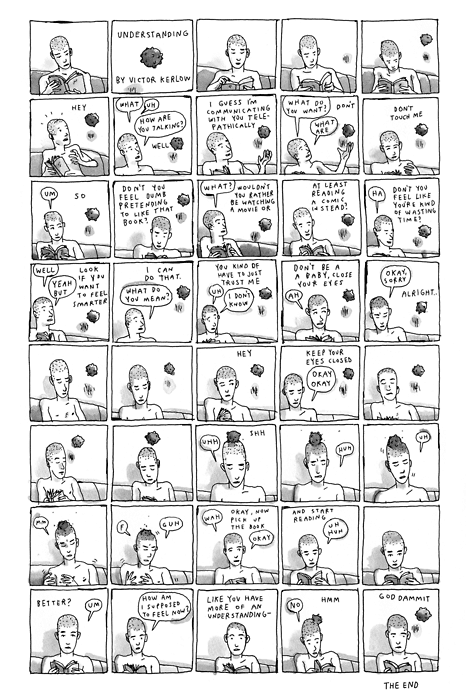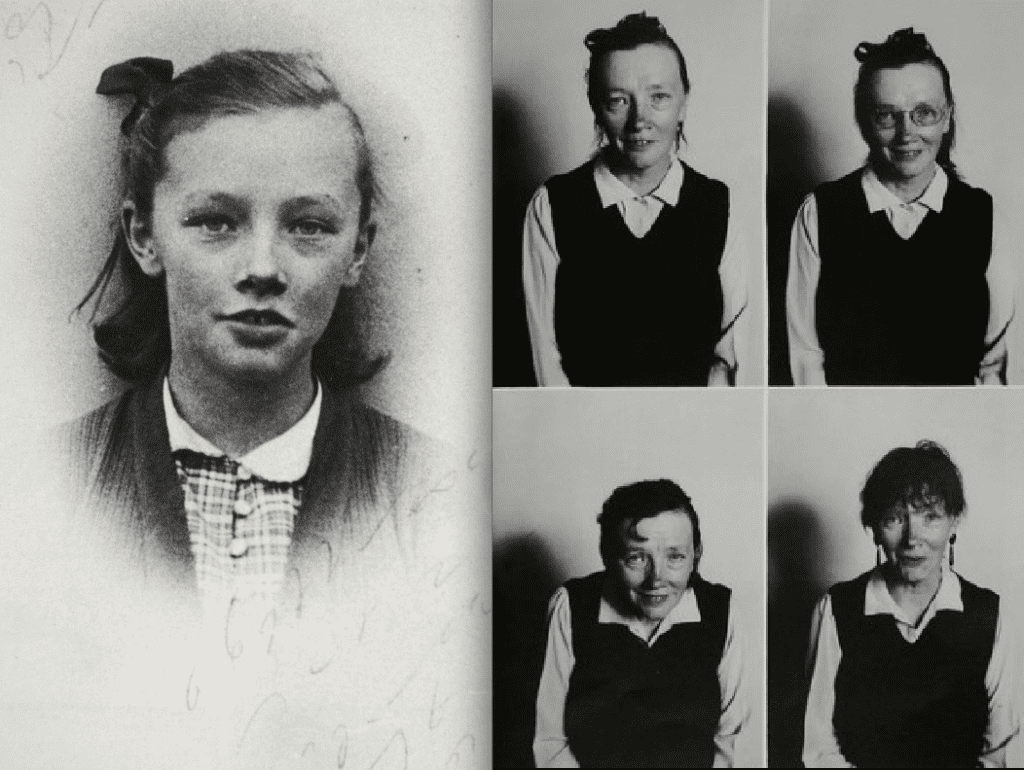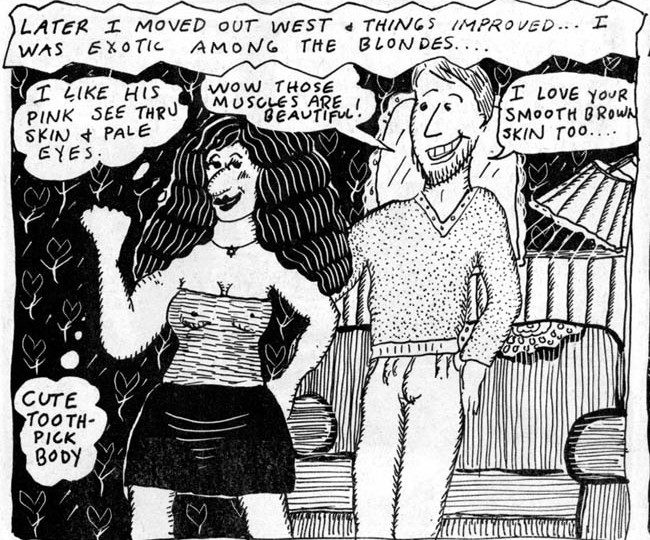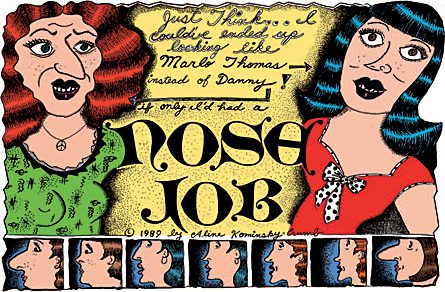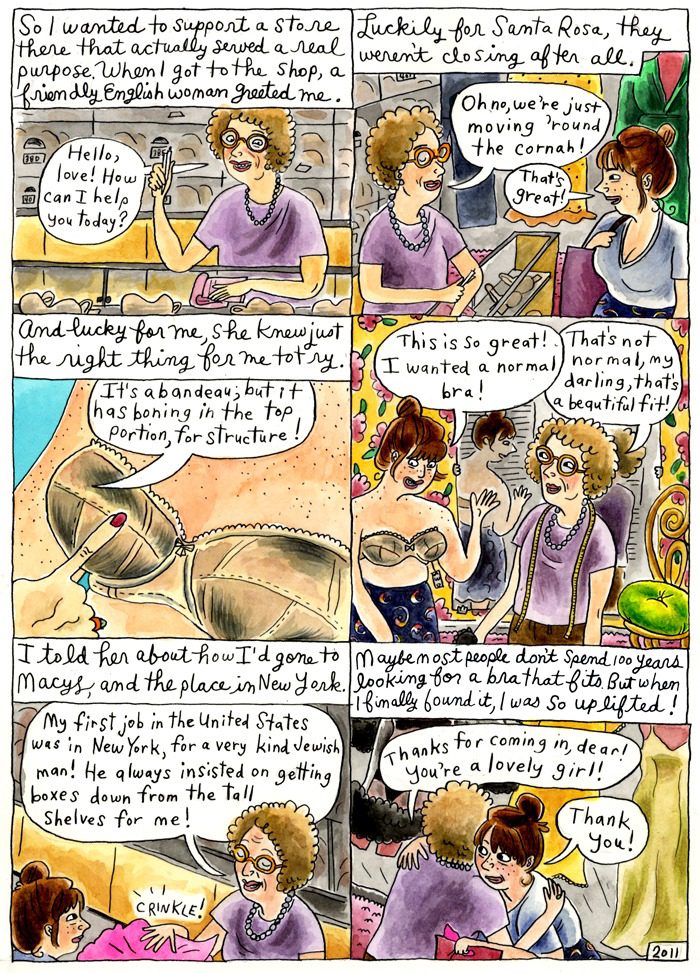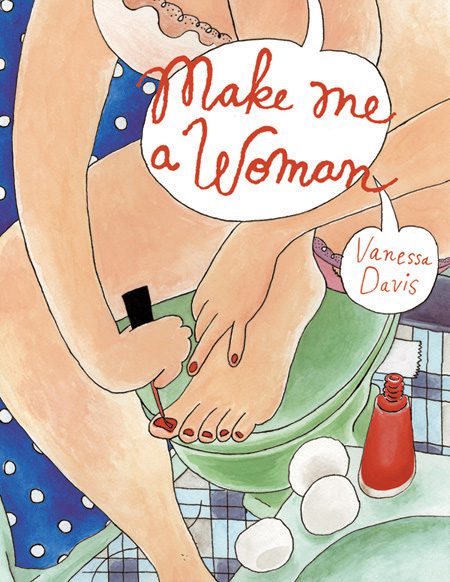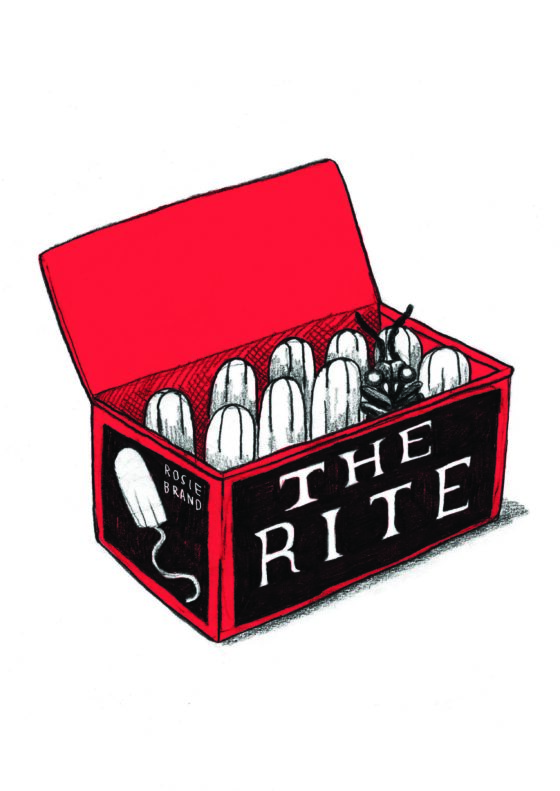The New York Comics & Picture-Story Symposium is a weekly forum for discussing the tradition and future of text/image work. Open to the public, it meets Monday nights 7-9pm EST in New York City. Presentations vary weekly and include everything from historical topics and technical demonstrations to creators presenting their work. Check out upcoming meetings here.
Cartoonist and illustrator Victor Kerlow and comics scholar Tahneer Oksman presented on their work last Monday night. Notably, this meeting also marked the first anniversary of the NY Comics and Picture-Story Symposium. Kerlow went first, showing past work and comics from his just-released book, Everything Takes Forever, from Koyama Press. Oksman spoke about how autobiographical comics depict female and Jewish identity.
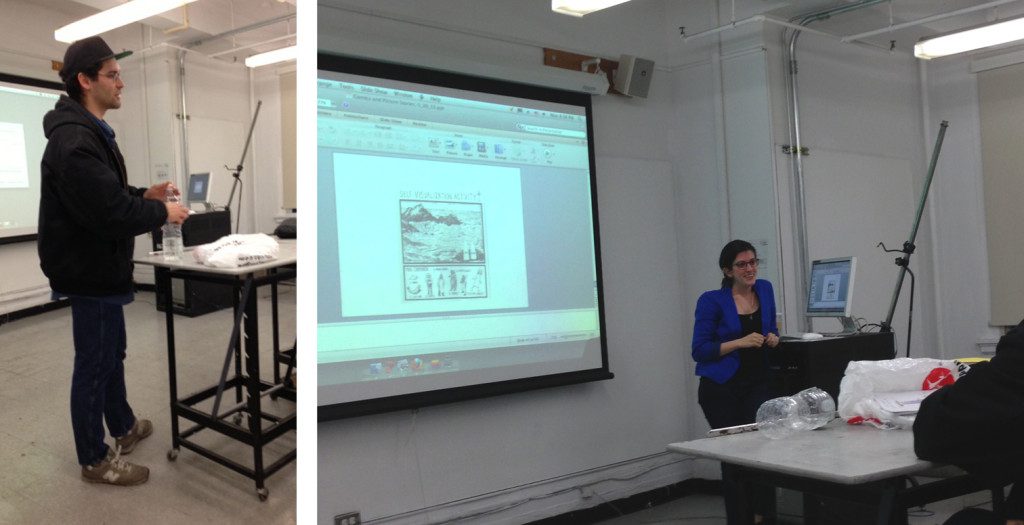 Kerlow began with the selection process that went into the cover for Everything Takes Forever, and so showed images calling back to previous projects and favorite things of his to draw. The final cover shows his well-known character, Taco Head, who was created during a Taco Bell drawing club night run by his friend, Jason Polan. Discarded covers included one in which he tried “to jam all the characters into one cover,” one with a giant head growing smaller heads like the mushrooms in Tintin: The Shooting Star (a favorite), and one patterned after Whac-A-Mole.
Kerlow began with the selection process that went into the cover for Everything Takes Forever, and so showed images calling back to previous projects and favorite things of his to draw. The final cover shows his well-known character, Taco Head, who was created during a Taco Bell drawing club night run by his friend, Jason Polan. Discarded covers included one in which he tried “to jam all the characters into one cover,” one with a giant head growing smaller heads like the mushrooms in Tintin: The Shooting Star (a favorite), and one patterned after Whac-A-Mole.
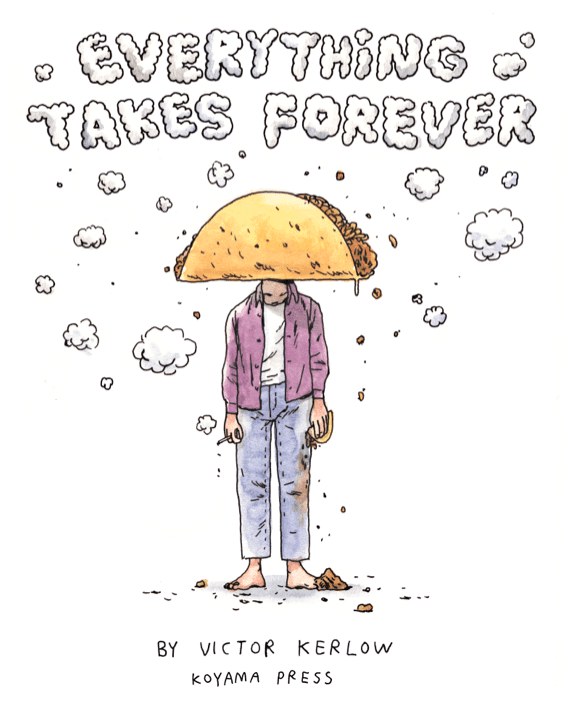 Originally, Kerlow wanted to do full watercolor comics for the book, but time constraints made him adopt a watercolor and flat color method you can see in Mama’s Boy. This comic, which he read aloud, demonstrates one of the ways he loves to tell stories. He took a random panel from a 1950s anti-smoking comic, the kind of preachy story where an older brother bullies his younger brother into smoking a cigarette, and then built a completely new story around it. The protagonist, a young guy with writhing green tentacles for a head, occupies every panel and simply describes what happened to him. “The whole point is to tell those really boring stories that no one wants to read but hopefully make them more interesting so they will read them,” he explained. “It’s one reason why I put all those weird characters into them…[they’re] soliloquies.” Later he mentioned how “a lot of the stories… are about pretty normal things.” Taco Head gets into a heated argument with a Taco Bell employee because he won’t sell him a taco. On the one hand, it’s incredible (and Taco Head points this out) that a walking taco would, or indeed could, eat a taco. On the other hand, tacos are delicious, and arguing with a fast food worker ties the surreal story to an ordinary experience.
Originally, Kerlow wanted to do full watercolor comics for the book, but time constraints made him adopt a watercolor and flat color method you can see in Mama’s Boy. This comic, which he read aloud, demonstrates one of the ways he loves to tell stories. He took a random panel from a 1950s anti-smoking comic, the kind of preachy story where an older brother bullies his younger brother into smoking a cigarette, and then built a completely new story around it. The protagonist, a young guy with writhing green tentacles for a head, occupies every panel and simply describes what happened to him. “The whole point is to tell those really boring stories that no one wants to read but hopefully make them more interesting so they will read them,” he explained. “It’s one reason why I put all those weird characters into them…[they’re] soliloquies.” Later he mentioned how “a lot of the stories… are about pretty normal things.” Taco Head gets into a heated argument with a Taco Bell employee because he won’t sell him a taco. On the one hand, it’s incredible (and Taco Head points this out) that a walking taco would, or indeed could, eat a taco. On the other hand, tacos are delicious, and arguing with a fast food worker ties the surreal story to an ordinary experience.
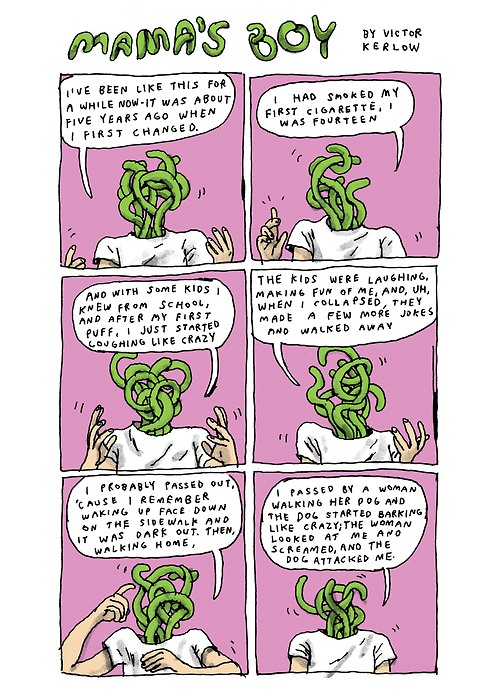 Kerlow’s comics follow the things that fascinate him. Surprise Fun!, a strip that appeared in Vice, channeled both his interest in yokai from manga and the frustrating experience of reading Prince Valiant newspaper comics in which a small amount of action gets broken up and drawn out by several strips. Kerlow hilariously demonstrated this frustrating process: “Let’s find the treasure! [pause] I found it! [pause] I’m opening the box! [pause] Oh come on!” He incorporated this staccato suspense into his reading of Surprise Fun!.
Kerlow’s comics follow the things that fascinate him. Surprise Fun!, a strip that appeared in Vice, channeled both his interest in yokai from manga and the frustrating experience of reading Prince Valiant newspaper comics in which a small amount of action gets broken up and drawn out by several strips. Kerlow hilariously demonstrated this frustrating process: “Let’s find the treasure! [pause] I found it! [pause] I’m opening the box! [pause] Oh come on!” He incorporated this staccato suspense into his reading of Surprise Fun!.
As with the mushrooms from Tintin: The Shooting Star, Kerlow takes his fascination with certain images or stories and incorporates them into his comics. That is Gossamer, the Looney Tunes monster, in the above image among all the yokai. Similarly, the vines from Mama’s Boy were partly inspired by the red tentacles in Princess Mononoke, and several page-break illustrations of Transformers toys came from an afternoon drawing toys with a friend. “I like drawing from life a lot,” he said.
Kerlow used his Q&A to explain his process. He prefers simply composed panels to panels composed of a lot of dynamic action, because the latter usually gets in the way of telling the story. “I go straight, I make a story up,” he said. “I use this character and make him tell a story…For longer comics, I’ll do six panels on every page, so I’ll figure out which dialogue fits on which page…I’ll draw something for an hour, then spend two hours on the computer fitting it and making sure it’s good. I enjoy that because it’s meditative, like swimming, because you can’t focus on anything besides that thing…I don’t do thumbnails, pencils…Belaboring it belabors it for me.”
***
As an academic, Tahneer Oksman pursues her fascination with comics by exploring how autobiographical comics shed light on their creators’ experiences (particularly as women and as Jews). She began with Lauren R. Weinstein’s The Best We Can Hope For, a large, intricate comic drawn in one panel with a bird’s eye view of characters passing each other in time and space in a park. Oksman highlighted the unusual way this comic engages the reader’s eye and affects the order and direction of reading it as a play on telling a story in time. A woman somersaults along the page and casually brushes by her child as he grows older. “These are separate moments, but they can meet on the page,” she said, pointing out one of the special qualities of comics as a medium among other media.
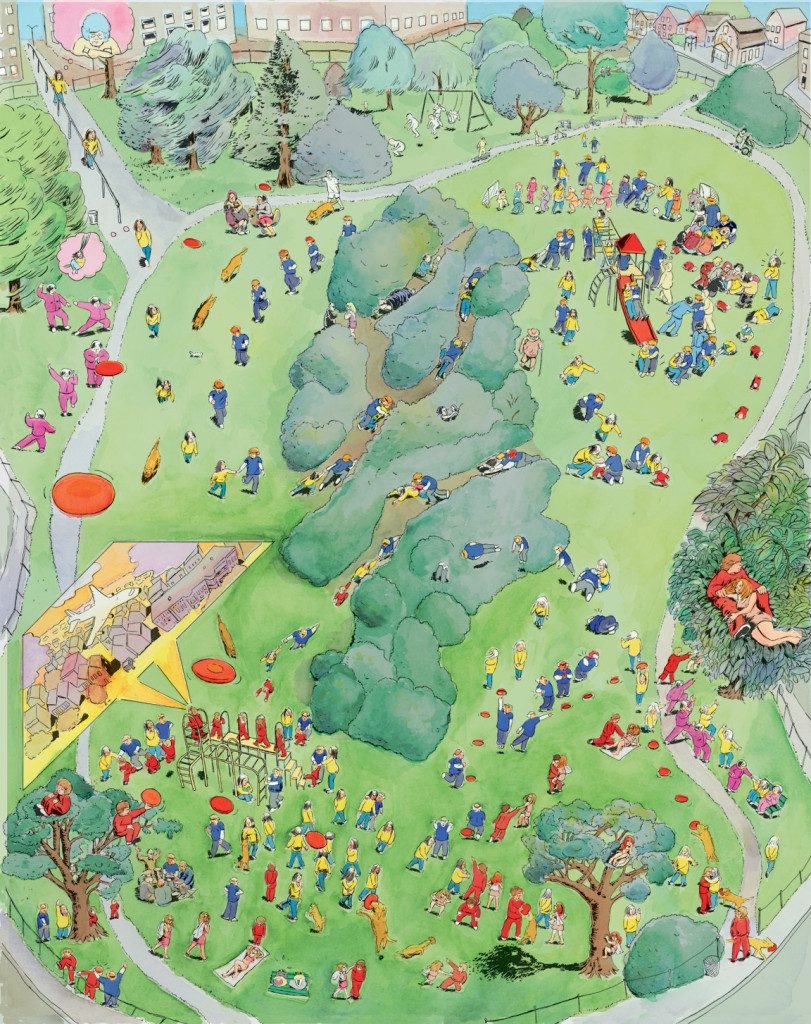 Oksman first came to study how comics represent the past after studying that dynamic in photography, specifically the photographic portraits of British artist Jo Spence. In her autobiographical photos, Spence played with representations of past and present. She juxtaposed an image of herself as a naked infant with an image of herself years later as a naked adult in a similar pose. She dressed herself up to match portraits from earlier times in her life. This allowed her to embody her past and use humor in her “exploration of the self.” A cartoonist who uses images for similar work is Aline Kominsky-Crumb, who also plays with past and present depictions of herself. Specifically, Oksman highlighted how artists like Spence and Kominsky-Crumb use their work to explore their identities as women. In one of Spence’s images, she took serial photos of herself dressed in a variety of ways: with a wig, without a wig, with more cleavage showing, with less, etc. “She takes a partial element of her identity and makes you look at it, or emphasizes that element on the page,” Oksman noted. It’s something that Kominsky-Crumb does with Jewishness as well as femaleness. As was later discussed during the Q&A, this approach to Jewishness stands in contrast to what could be considered a more typical male Jewish immigrant stance with the superhero assimilationist model.
Oksman first came to study how comics represent the past after studying that dynamic in photography, specifically the photographic portraits of British artist Jo Spence. In her autobiographical photos, Spence played with representations of past and present. She juxtaposed an image of herself as a naked infant with an image of herself years later as a naked adult in a similar pose. She dressed herself up to match portraits from earlier times in her life. This allowed her to embody her past and use humor in her “exploration of the self.” A cartoonist who uses images for similar work is Aline Kominsky-Crumb, who also plays with past and present depictions of herself. Specifically, Oksman highlighted how artists like Spence and Kominsky-Crumb use their work to explore their identities as women. In one of Spence’s images, she took serial photos of herself dressed in a variety of ways: with a wig, without a wig, with more cleavage showing, with less, etc. “She takes a partial element of her identity and makes you look at it, or emphasizes that element on the page,” Oksman noted. It’s something that Kominsky-Crumb does with Jewishness as well as femaleness. As was later discussed during the Q&A, this approach to Jewishness stands in contrast to what could be considered a more typical male Jewish immigrant stance with the superhero assimilationist model.
Oksman looked at Kominsky-Crumb’s 1972 comic Goldie for its depiction of the author as a child, a teenager, and then an adult, and how she showed her family’s Jewishness with their physicality and immigrant vernacular. In comics like Nose Job, she plays with stereotypes and owns them in a way that gives her control over them. Oksman brought up another cartoonist drawing about Jewishness and femininity: Vanessa Davis. Both Davis and Kominsky-Crumb are “trying to distance themselves from their Jewish identity while they also write about it.”
Davis’s Make Me a Woman plays with the idea of a memoirist laying everything bare (literally, in these stories), but also concealing information with personae and manipulation of point of view. In Weinstein’s book, Girl Stories, the protagonist’s first kiss ends with a cross-section of the participants’ mouths and tongues. Weinstein plays with her depiction of remembering this moment by taking this adolescent experience and suddenly showing it from a hilarious, gross angle. These cartoonists all experiment with the idea of memoir and diaries in a similar way to how Spence messed with the idea of what a family photo album is. Another major theme Oksman notices among these female creators is how often they play with genre.
Ending the evening with a brief Q&A, Oksman noted a generational difference between these Jewish female cartoonists: the later creators tend not to be as invested in symbols and stereotypes as the earlier ones, perhaps because of a different stance on assimilation.
***
Image 1: Andrea Tsurumi, Photo of Victor Kerlow and Tahneer Oksman, 2013
Image 2: Victor Kerlow, Everything Takes Forever cover, Koyama Press, 2013
Image 3: Victor Kerlow, page one of Mama’s Boy, 2013
Image 4: Victor Kerlow, Surprise Fun!, Vice Magazine, 2012
Image 5: Victor Kerlow, Understanding, 2013
Image 6: Lauren R. Weinstein, The Best We Can Hope For
Image 7: Jo Spence, Beyond the Family Album, 1979
Image 8: Aline Kominsky-Crumb, panel from Sex Crazed Housewife or My Troubles with Men, 1981
Image 9: Aline Kominsky-Crumb, Nose Job, 1989
Image 10: Vanessa Davis, last page of Support System, Tablet Magazine, 2011
Image 11: Vanessa Davis, cover of Make Me a Woman, D&Q, 2010
***
About the author: Andrea Tsurumi is an illustrator and cartoonist living in New York City. You can see her work here and her latest projects here.

